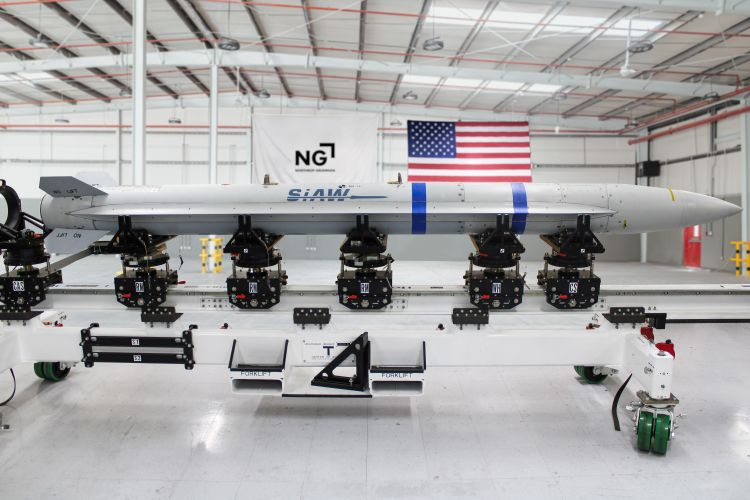Northrop Grumman has delivered its first Stand-in Attack Weapon, which will be used for captive carry and separation testing, to the Air Force. The SiAW is expected to be produced in high numbers and be carried by most Air Force strike platforms, with initial operational capability planned in 2026.
The company received a $705 million contract for SiAW in September 2023, and is on an aggressive timetable to develop, flight test, and integrate the missile. The company has said it can make the 2026 target because the SiAW draws heavily on the technology in its Advanced Anti-Radar Guided Missile-Extended Range (AARGM-ER), which is taking over the anti-radar/defense suppression role previously performed by the AGM-88 High speed Anti-Radiation Missile (HARM).
The AARGM-ER has been integrated with the F-35 fighter, which will also be the initial platform for the SiAW; the fighter can carry two SiAWs internally. Other platforms expected to receive early versions of the weapon include the B-21 bomber and the F-15E.
The SiAW will also, in part, succeed the Joint Direct Attack Munition, and is intended to provide stand-off capability against surface defenses and rapidly relocatable targets.
With the missile now in “Phase 2” of development, the Air Force and Northrop will look to conduct captive carry/separation tests, followed by a guided flight test. After that, Phase 2.2 will conclude with “three additional flight tests and the delivery of SiAW leave-behind prototype missiles and test assets,” Northrop said.
Air Force leaders have said they expect SiAW to be a large-scale acquisition program involving thousands of units with frequent technology updates, and will probably be available for export to close allies as soon as production reaches scale. The similar AARGM-ER is being supplied to Australia, the Netherlands, and Poland. Australia’s initial purchase was for 63 AARGM-ERs, which it will deploy on its F/A-18 fighters.
Northrop beat out L3Harris for the development contract; Lockheed Martin withdrew from the competition.
The munition is being developed using digital engineering, agile software development, and an open systems architecture to facilitate rapid upgrades. Northrop has said it will be the Air Force’s first all-digital weapons development and acquisition program.
The open architecture will allow contractors other than Northrop to propose updates for the missile.
Northrop describes the SiAW as addressing “capability gaps created by 2025+ threats.” Although branded a “stand-in” weapon, Northrop said the weapon can be delivered “from sanctuary,” meaning at distances outside the engagement zones of some anti-aircraft systems. Its actual range and speed have not been divulged, but the AARGM-ER is believed to be a Mach 4 missile with a range of 180 miles, and the SiAW may have better performance.
The SiAW has tail-control vanes and other means of being stealthy, according to Northrop, and has multiple sensors and an inertial navigation system that can take over if Global Positioning System satellite location signals are jammed. It can also communicate with other platforms and weapons and attack target coordinates supplied by another platform.
The company is developing and building the SiAW at its Northridge, Calif., facilities, and integrating it at the Allegany Ballistics Laboratory in West Virginia.
The HARM was an extremely effective weapon in Operation Desert Storm in 1991. Iraqi ground-based search and track radar operators were deterred from turning on their radars because a HARM usually arrived a few seconds after activation and before the radar could be moved. The AARGM and SiAW are faster than HARM, but it’s unclear as to whether the weapon can achieve hypersonic speeds.
In addition to surface defenses, Northrop has said the SiAW will be a primary weapon for use against command-and-control sites; ballistic and cruise missile launchers; GPS jamming systems; anti-satellite systems and other high-value or “fleeting” targets.


